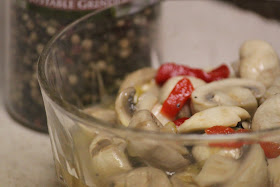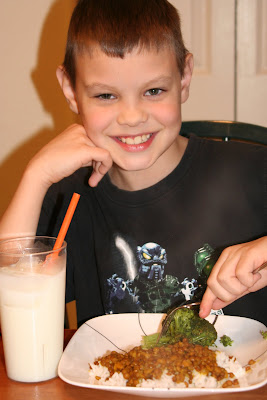

My dad celebrated his 80th birthday this past June 27th, and all three of us (his daughters) traveled across the country with our families for the big occasion. My sister Carol planned most of the party details, and she decided on a racing theme with a black, white, green and blue color scheme. I got it into my head to make some kind of birthday banner that we could hang outside near the festivities, and the banner that I came up with is shown in the photos above.
I started with a banner template set that I purchased online from Oriental Trading Company. The set has various templates to make banners in a number of different shapes, but since I was just using basic triangles for my banner, I probably could have done without the templates. Or, I could have easily made my own from heavy plastic. But, since I had the templates, I used them. The triangle template had two different cutting lines, so I used the "inside" line to cut my colored cardstock, and the larger, "outside" line to cut the black cardstock pieces. For the black pieces, I traced the template onto black cardstock and cut the penciled shape out with decorative "zig-zag" scissors. I then mounted the green and blue pieces on the inside of the black pieces.
My kind neighbor cut out the "Happy Birthday" sayings for me using her Cricut. We played around with a couple of different sizes to see which would work best and fit closely within the triangles. I used glue to adhere the "Happy Birthday" pieces to the triangles. The beach ball and package die cuts were made with my Quickutz, using scraps left over from cutting out the green and blue triangles. The "80" on every other triangle was also cut using a Quickutz font. After I finished decorating all of the individual triangle banner pieces, I set an eyelet into the two top corners of each piece. Since I had to travel with my banner, I wanted to be able to store it flat and then actually put it together when we got to my dad's house and were setting up for the party.
To assemble the banner, I simply tied pieces of white curling ribbon through each set of eyelets, and tied the pieces in knots. I wanted the banner to be flexible because I needed it to fit the space that we had available.
As you can see from the photo, the finished banner ended up looking very nice hung along the edge of my dad's covered patio. The bright and contrasting colors made it very easy to see, and it really added a nice touch to the party atmosphere. A couple of words of warning, though. The first is that paper, particularly multiple layers of cardstock, can get REALLY heavy. My banner was quite long (about 25 individual triangle pieces) and as we were putting it up, we discovered that it was simply too heavy to hang across a large open area with just the ends supporting the weight of the banner. So we ended up using a support in the middle, as well, but that wasn't something I had expected. The second warning is that it sometimes rains in the summer, and paper gets . . . wet. Yep, we had a late afternoon thunderstorm and even though the banner was partially protected from the elements, it got wet enough that eventually a few of the eyelets ripped out and down the banner came. In hindsight, we should have hung it either inside near the cake table, or across a more protected area. However, the banner served its purpose and it wasn't supposed to be a cherished keepsake, just a fun party decoration, so it didn't upset me too much when the whole thing collapsed.
Since my dad's party, I've made a couple of variations of this banner, including one to cheer on a gal at work who was selected to run in a special Labor Day race in our area. Since I needed to produce that banner virtually overnight, I just used pre-made embellishments and letter stickers to decorate the triangles. Also, I fastened the individual triangles together at the corners with mini brads rather than eyelets, and I found that the banner still had a lot of flexibility, but was quite secure when it was hanging up.
So the next time you have an occasion to celebrate, forget the pre-made banner from the party store, and make one of your own, using your scrapping supplies and little bit of creativity.























